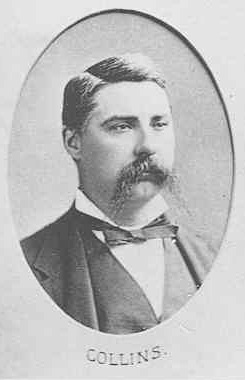Jerome J. Collins facts for kids
Quick facts for kids
Jerome J Collins
|
|
|---|---|
 |
|
| Personal details | |
| Born | October 17, 1841 Cork City, Ireland |
| Died | October 30, 1881 (aged 40) Lena Delta, Russia |
| Resting place | Curraghkippane Cemetery, County Cork |
| Nationality | Irish, American |
| Occupation | Meteorologist, Irish republican activist, journalist, civil engineer, Arctic explorer |
| Known for | Founding Clan na Gael in the US, death in Jeannette expedition |
Jerome J. Collins (1841–1881) was an Irish-American journalist, weather expert, and engineer. He started a group called Clan na Gael in the United States, which supported Irish independence. Jerome Collins also became a meteorologist and reporter for a newspaper. He joined a dangerous trip to the Arctic called the Jeannette Arctic Expedition, where he sadly passed away.
Contents
Early Life and Irish Activism
Jerome Janus Collins was born in Cork City, Ireland, on October 17, 1841. His father, Mark Collins, owned a business that made lime and salt. Jerome went to St Vincent's Seminary in Cork and later became a civil engineer. He helped build Cork city's North Gate Bridge in 1864.
After that, he moved to London for more engineering work. While there, he got involved in a plan to help Irish political prisoners, known as Fenians, escape from Pentonville Prison. When this plan was discovered, he had to quickly leave for the United States in 1866.
When he arrived in America, he found that the Fenian movement was divided. To bring them together, he started a new group called the Napper Tandy Club in New York on June 20, 1867. This club was named after an Irish rebel, Wolfe Tone. The Napper Tandy Club soon grew into the much larger and more powerful organization known as Clan Na Gael.
In the 1870s, Collins became less involved in the daily activities of Clan na Gael as it became more focused on military actions. However, he remained good friends with its leaders, John Devoy and William Carroll.
Becoming a Weather Expert
Jerome Collins worked at the New York Herald newspaper. At first, he was a science reporter. He was very interested in weather and thought that using telegraph messages could help predict the weather better.
In 1875, James Gordon Bennett, who owned the newspaper, made Collins the "Clerk of the Weather." This meant Collins was in charge of the Herald's Meteorology Department. Collins collected weather information from all over the United States. He used this data to predict storm systems moving across the Atlantic Ocean towards Europe. Even though he could predict storms, it was hard to be very accurate, especially in the first year of the department.
The Jeannette Arctic Expedition
James Gordon Bennett Jr., the newspaper owner, liked to fund big adventures to get news for his papers. He decided to pay for an expedition to try and reach the North Pole. The idea was to use a warm ocean current, the Kuro Siwo Current, through the Bering Strait.
An American Naval Officer named George W. De Long was looking for support for an Arctic trip. Bennett bought a British Navy ship called HMS Pandora, which had already been made stronger for Arctic travel. It had been used before to search for survivors of the Franklin Expedition.
Bennett asked Collins to join the expedition as the meteorologist, reporter, and main scientist. Collins was responsible for taking care of all the scientific equipment on the ship. With more funding, the ship was renamed USS Jeannette. It left San Francisco on July 9, 1879, with De Long as its commander.
Collins and De Long did not get along well. De Long, being a naval officer, thought that civilians like Collins were "unnecessary." He was annoyed that Collins, who was very independent, didn't always follow his orders. Collins also faced some unkindness from parts of the crew because he was Irish Catholic.
In September 1879, the Jeannette got stuck in thick ice. This made the tension between Collins and De Long even worse. In December 1880, De Long removed Collins from his position because he felt Collins was not respecting orders.
After being trapped in the ice for fifteen months, the ship started to break apart in June 1881. The crew had to leave the ship in three lifeboats. Collins and De Long were in the same lifeboat. They eventually landed near the Lena Delta on the coast of Siberia.
Death and Lasting Impact
Sadly, the entire group eventually died from the cold and hunger. De Long's diary, which was found later, noted that Jerome Collins passed away on October 30, 1881.
The Navy brought the bodies of Collins and the other crew members back to the United States. They had a large public funeral in New York on February 22, 1884. Collins's body was then returned to County Cork, Ireland, and buried in March 1884.
His brother, Daniel Collins, was upset when a government investigation into the Jeannette disaster showed that Jerome had been treated poorly by De Long. Daniel Collins worked to have a second investigation to clear his brother's name. However, the results of this second inquiry supported the findings of the first one.
On September 30, 1890, the U.S. Congress honored Jerome J. Collins with a Congressional Gold Medal. This medal was also given to the other officers, both living and dead, who had been part of the Jeannette expedition.

